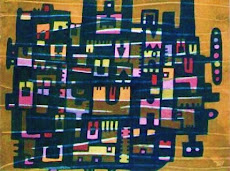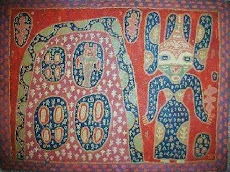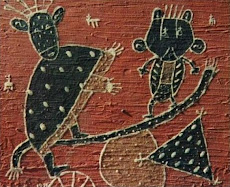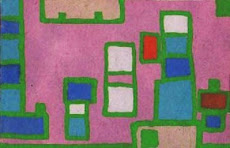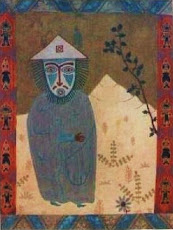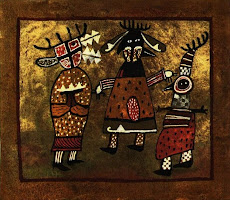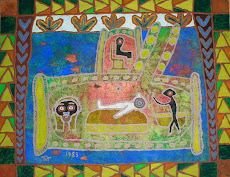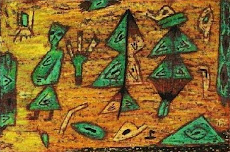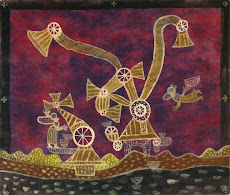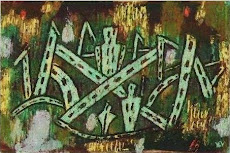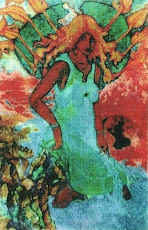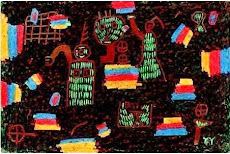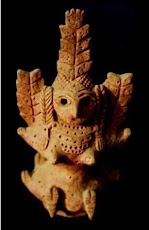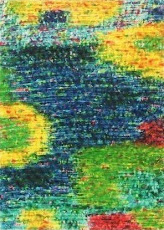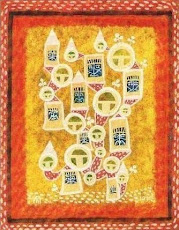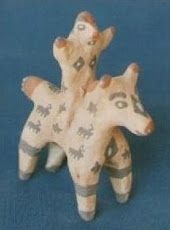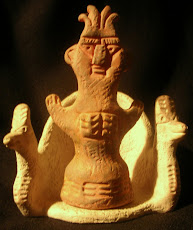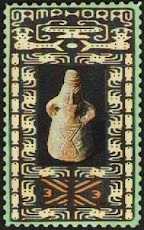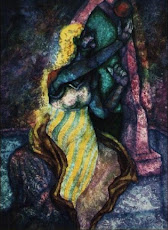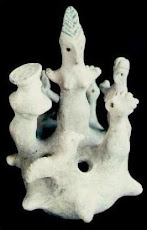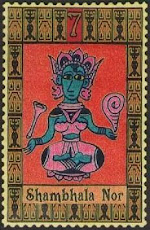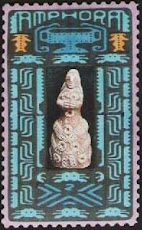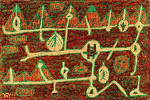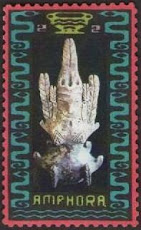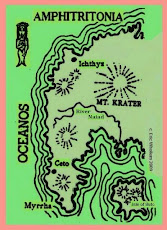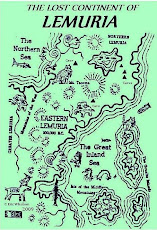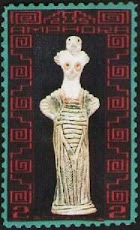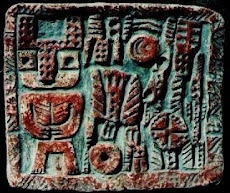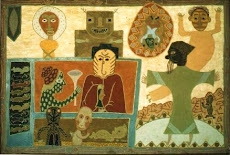Tara Rising From the Mysterious Waters of the Lake of the North
or
A MAP TO SHAMBHALA
2010or
A MAP TO SHAMBHALA
by Eric Whollem
Copyright by the artist
The Way to Kalapa
& The Lake of Shambhala Nor
Mystics of Tibet, Mongolia, Russia, India and Central Asia
have long searched for Shambhala. It is said to be a mystic
realm hidden from the eyes of men. Some say it can only be
reached after intense purification and meditation.
The Bon Po shamans, who lived in Tibet long before the
Buddhists, spoke of the land of Ol mo lung ring. They
visualized it as a square mandala with Kalapa, the central
city in the center. A nine-storied palace stood in the island
at the hub. This land later became known as Shambhala.
In the Kalachakra system of Tibetan Buddhism, Kalapa
is said to exist on an eight petalled lotus isle surrounded
by mountains. Edwin Bernbaum, who wrote A Way to
Shambhala, relates that the lotus isle of Kalapa is set in
river water.
In some accounts the hidden city of Sadarsana at the top
of Mt. Meru (or Kailas) is identical with Kalapa.
The Kirghiz people also speak of the hidden city of Janaidar
which sits on the peak of Mustagh Ata. A white camel is
found near a lake at the top of this mountain. The Kirghiz
are an Altai people who live deep in Central Asia.
Other Tibetan views place Shambhala in the far north,
perhaps in the arctic. Uttarakuru means the land of the
far north. It is spoken of as another possible location of
the realm of Shambhala.
Uttarakuru
2010
by Eric Whollem
COPYRIGHT BY THE ARTIST
In the fairy lore of Persia it is said that the Peris, or fairies,
live in a place to the north called The Desert Island. This
legend parallels the stories of the island home of Kalapa,
Shambhala's capital city.
Shangri La and Shambhala
The novel, Lost Horizon, takes the Shambhala legend and
gives us the famous name of Shangri La. There is no doubt
that the author was somewhat familiar with Tibetan accounts
of Shambhala.
In the early 20th century Charles W. Leadbeater authored
books for the Theosophical Society called, The Hidden
Side of Things and The Masters. In these texts he describes
the Ascended Masters' retreats in hidden places in Tibet. He
describes archives of all human knowledge stored away in
secret libraries. This may have been the source of the Shangri
La story.
Peach Blossom River
The Chinese mystics, who long saw the mountains to the
west as the paradise of Peach Blossom River, called
Shambhala the Continent of Treasures. There is a famous
story of how Lao Tzu, weary with age, decided to leave
the earthly plane. He mounted the back of a water buffalo
and attempted to disappear into the Kun Lun Mountains.
A gate keeper would not let him through until he revealed
his wisdom. The result is the text of the Tao Te Ching.
Lao Tzu's journey was to the palace of Hsi Wang Mu,
at the headwaters of the Yellow River.
Peaches are the most sacred fruit of the Chinese. The
ancient Taoist masters used peach wood wands to draw
magic oracular shamanic diagrams in sand.
Crossing the White Water
The Ch'u T'zu poems of the third century B.C. describe
Li Sao's journey to fairyland, which is delineated as the
"ocean of the west." The west of China is desert. This
imagery could be a mystical view of an etheric ocean, as
the Gobi Desert is bereft of water. The ocean of the west
appears in Chinese folklore as the destiny of the spirits of
the dead. Could they be describing a version of the
Shambhala legend--with Shambhala as a sort of fairylike
heavenworld?
Li Sao crosses the White Water to reach fairyland. The
White Water is one of four rivers that flow from the Chinese
mandala of Kun Lun. The Yellow River along with the white,
black and red waters form this mandala.
Mandala of the Four Rivers
Lake Manasowar, near Kailas in Tibet, also has four rivers
that flow from it. Also Viking lore speaks of four rivers of
milk that flow from the udder of the mystic cow.
Thus the Four Rivers that flow from the Palace of Hsi Wang
Mu are mirrored in legends spread across Europe and Asia.
Altai Mysticism
Russian mystics bear tales of a lost paradise
which they said lies in The White Waters, or Belovodie.
They said that a portal to Shambhala exists near Mt.
Belukha in the Altai Mountains. Other stories say there
is a portal at Jugili Mountain near the Volga. Yet other
tales are about subterranean accesses somewhere on
the backside of the Urals.
Frequently sacred mountainous places are said in the
folklore of the people who honor them to have mystic
access through secret caves. Mt. Shasta in Northern
California is such a sacred mountain.*
*I got a lot of this data on Russian mysticism from a website
called Shalagram.Ru established by the Noosphere
Research Insitute. This site gives a very interesting
account of cosmic cartography, interpreting Shambhala
in the light of Celtic, Hopi, and other mystic lore. (Chapter
6 is recommended reading.)
The Legend of Kalki
The Kalachakra traditions of Vajrayana Buddhism
relate that at the end of times Kalki, a great hero, shall
arise as King of Shambhala and eliminate evil from the
world. Kalki would come on horseback to serve as the
savior of Buddhists.
Kalki
2010
by Eric Whollem
COPYRIGHT BY THE ARTIST
In the scriptures of India, Kalki is referred to as the
tenth incarnation of Vishnu, an incarnation to come.
The Kalki Purana speaks of his exploits in detail.
Tarthang Tulku's book, Mother of Knowledge, the
Enlightenment of Ye-shes m'Tsorgyal, bears a very
interesting bit of scriptural prophecy concerning the
future of Tibet. The account there parallels what we
have said concerning Kalki, the King of Shambhala.
A description ensues of the return of Buddhism after
Tibet is overrun with destroyers of the faith.
Ye-shes m'Tsorgyal or Jnanasagara (Sea Wisdom)
is the foremost female author of Tibetan wisdom
teachings.
Roseapple Island
A DIGRESSION ON JAMBUDVIPA
India has long been called the continent of Jambudvipa,
or The Roseapple Island. India is thus a part of the
apple island legends of the world. The Greek Hesperides
are one such group of apple islands. The Hawaiian
Islands are another group of apple islands. The Garden
of Eden with it's apples may relate to these legends.
Apples are ancient symbols of the human soul. In
Celtic legend apple boughs are carried on the sea
chariot of Mananaan McLer, the sea god. And the
curious animal, the Nidhog, a sea pig, is said to be
the consumer of souls...in the form of apples.
The Hebrides off the coast of Scotland are named
after the Greek Hesperides and thus also must be
included among the apple isles.
The most famous apple island of all is Avalon, the
mystic isle of King Arthur. Arthur's name stems from
Ausar, the Egyptian God of the Great Green Sea,
better known as Osiris.
The apple island legends may stem from an
archtypical legend from Heliopolis in Egypt, the
story of the land of swallows. The birds on this
island were said to be the souls of mankind.
The Egyptian Tuat
A COMPARISON TO THE MANDALA OF SHAMBHALA
The Tuat was the name given to the place of the
Blessed Fields of the Dead, Sekhet-Aanru. This
was a field of reeds in the utmost northern
constellation.
It was encircled by river water. This was the mystic
Nile of the beyond. The hieroglyph for the Tuat is
rectilinear, which recalls the square mandala of
Ol mo lung ring, the prebuddhistic Shambhala of
Tibet.
The constellation of the north pole was a great fish
to the mind of the ancient Egyptians. The four
guardians of Horus stand at it's four corners. In
India the constellation of the north is Sisumara, the
porpoise.
The Hindu Paradise of Uttarakuru and the White
Waters of Belovodie recall the Tuat. A number of
Tibetan practitioners have identified the north pole
as the location of Shambhala, the crown chakra of
the earth.
Tara Rising From the Waters
FROM THE MAP TO SHAMBHALA
Tara is described in the Lankavatara Sutra and
also The Legends of the Mahasiddhas as dwelling
in the sea.
She rose from the palace of the King of Sea Serpents
to give the sage Nagarjuna the Prajnaparamita teachings.
Dakinis, or female demigods, are also frequently
described as living in lakes.
The Nagas
Tara and the Dakinis thus could be said to belong to
the categories of Naiads and Oceanids from European
legend. Like the Apsaras of the Rig Veda, or Benten,
the Daughter of the Sea King, from Japan, they are not
depicted with the fish tails of mermaids, but stand on
two feet. The Greeks also gave their aquatic demigods
feet. However the Nagas and Naginis of Tibet and India
bear closer ressemblance to our popular notions of the
mermaids and mermen--having the upper torsos of
humans but the tails of cobras--symbols of Kundalini.
Pancha Raksha
A YIDAM OR TUTELARY GUARDIAN
Not far from Mt. Kailas (Meru) is a Tibetan monastery
with a depiction of Pancha Raksha, a Tibetan Nagini.*
This video presents my stamps from Shambhala Nor:
____________________________________
*She appears on the stamps of Shambhala Nor.
Readers interested in my posts on the subject of Shamanism may want to see this link:
My posts on Mythology may be found here:
For my posts on Mythographic Art see:
http://artblogericwhollem.blogspot.com/search/label/mythographic%20art
SHAMBHALA NOR POST
2000
by Eric Whollem
COPYRIGHT BY THE ARTIST
For my gallery of FAUX POSTAGE STAMPS from Shambhala Nor see:
SHAMBHALA NOR POST
2000
by Eric Whollem
COPYRIGHT BY THE ARTIST
For my gallery of FAUX POSTAGE STAMPS from Shambhala Nor see:
A LETTER FROM SHAMBHALA
Eric Whollem
2010
copyright by the artist
View more of my fantasy letters from Shambhala on the link below:
http://artblogericwhollem.blogspot.com/2015/10/letters-from-shambhala-tibetan-fantasy.html
*
Artist stamps, artistamps, cinderella stamps, fantasy stamps, faux postage, mail art, micronation stamps by Eric Whollem; spirituality, meditation, Buddhist American Folk Art, metaphysical art, mythology, shamanism.
*
*























